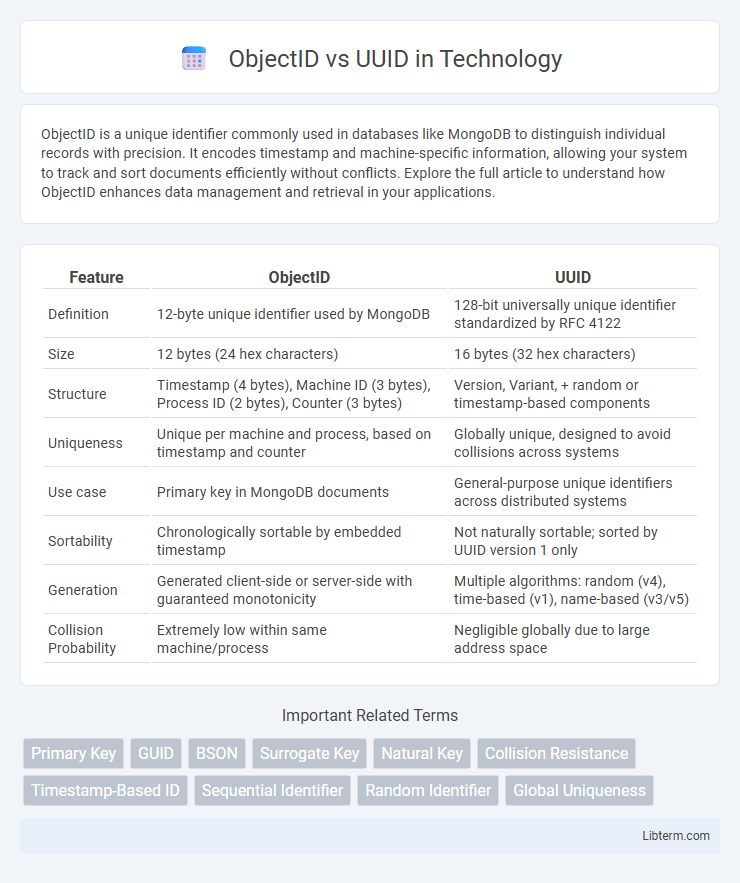ObjectID is a unique identifier commonly used in databases like MongoDB to distinguish individual records with precision. It encodes timestamp and machine-specific information, allowing your system to track and sort documents efficiently without conflicts. Explore the full article to understand how ObjectID enhances data management and retrieval in your applications.
Table of Comparison
| Feature | ObjectID | UUID |
|---|---|---|
| Definition | 12-byte unique identifier used by MongoDB | 128-bit universally unique identifier standardized by RFC 4122 |
| Size | 12 bytes (24 hex characters) | 16 bytes (32 hex characters) |
| Structure | Timestamp (4 bytes), Machine ID (3 bytes), Process ID (2 bytes), Counter (3 bytes) | Version, Variant, + random or timestamp-based components |
| Uniqueness | Unique per machine and process, based on timestamp and counter | Globally unique, designed to avoid collisions across systems |
| Use case | Primary key in MongoDB documents | General-purpose unique identifiers across distributed systems |
| Sortability | Chronologically sortable by embedded timestamp | Not naturally sortable; sorted by UUID version 1 only |
| Generation | Generated client-side or server-side with guaranteed monotonicity | Multiple algorithms: random (v4), time-based (v1), name-based (v3/v5) |
| Collision Probability | Extremely low within same machine/process | Negligible globally due to large address space |
Introduction to ObjectID and UUID
ObjectID, primarily used in MongoDB, is a 12-byte unique identifier consisting of a timestamp, machine identifier, process ID, and a counter, enabling efficient storage and generation with embedded creation time. UUID (Universally Unique Identifier) is a 128-bit value standardized by RFC 4122, designed for distributed systems to guarantee uniqueness across space and time without centralized coordination. Both ObjectID and UUID serve as unique keys but differ in structure and use cases, with ObjectID favoring compactness and chronological ordering, while UUID emphasizes global uniqueness.
What is ObjectID?
ObjectID is a 12-byte identifier used as the default primary key in MongoDB documents, designed to be unique across distributed systems. It consists of a 4-byte timestamp, a 5-byte random value, and a 3-byte incrementing counter, enabling efficient sorting by creation time. This structure allows ObjectIDs to provide both uniqueness and temporal ordering without additional storage overhead.
What is UUID?
UUID (Universally Unique Identifier) is a 128-bit value used to uniquely identify information in distributed systems, ensuring global uniqueness across devices and time. It is commonly represented as a 36-character string, including hexadecimal digits and hyphens, formatted into five groups (8-4-4-4-12). UUIDs follow standards like RFC 4122 and are widely used in databases, software development, and network protocols for reliably generating unique keys without a central authority.
Structural Differences: ObjectID vs UUID
ObjectID is a 12-byte identifier consisting of a 4-byte timestamp, 5-byte random value, and 3-byte incrementing counter, designed to ensure uniqueness within distributed systems and orderability by creation time. UUID (Universally Unique Identifier), specifically version 4, is a 16-byte (128-bit) random or pseudo-random number, standardized to provide a vast address space for unique identification without embedded time-based information. The structural difference lies in ObjectID's compact, timestamp-embedded format enabling temporal sorting, compared to UUID's fixed-length, purely random or namespace-based structure focused on uniqueness across systems without inherent ordering.
Generation & Uniqueness Methods
ObjectID utilizes a 12-byte structure combining a 4-byte timestamp, 5-byte random value, and 3-byte incrementing counter to ensure uniqueness within a distributed system. UUID relies on standardized algorithms that include time-based, name-based, and random generation methods, producing a 128-bit identifier with a very low probability of collision. ObjectID's timestamp component facilitates chronological ordering, while UUID's variant and version fields provide flexibility and interoperability across different platforms and applications.
Storage Efficiency and Performance
ObjectID, a 12-byte identifier used in MongoDB, provides significant storage efficiency compared to the 16-byte UUID due to its smaller size and embedded timestamp, which reduces indexing overhead. Performance-wise, ObjectID improves query speed by enabling chronological sorting based on the embedded timestamp, enhancing range scans and shard key distribution. In contrast, UUIDs, while globally unique, may lead to larger index sizes and slower index traversal due to their randomness and longer byte length, impacting database storage and retrieval efficiency.
Use Cases: When to Use ObjectID
ObjectID is ideal for MongoDB applications requiring compact, time-ordered unique identifiers that embed creation timestamp and machine data, facilitating efficient indexing and sorting. It suits distributed systems where generating unique IDs without coordination is essential, especially when insertion order matters. Use ObjectID in scenarios demanding fast, scalable write operations with lightweight identifiers, such as logging events or session tracking.
Use Cases: When to Use UUID
UUIDs are ideal for distributed systems requiring globally unique identifiers without coordination, such as in microservices, cloud applications, and database replication scenarios. They provide strong collision resistance across different environments, making them suitable for offline data generation and merging heterogeneous data sources. Use UUIDs when interoperability and decentralization are critical, especially in scenarios involving data synchronization across multiple independent systems.
Security and Predictability Considerations
ObjectID offers predictable timestamp and machine identifier components that can expose system patterns and increase security risks through potential tracking or enumeration attacks. UUIDs, especially version 4, generate random or pseudo-random values that enhance security by minimizing predictability and reducing the chance of collision across distributed systems. Choosing UUIDs strengthens defense against enumeration and replay attacks due to their high entropy and non-sequential nature, while ObjectIDs may require additional safeguards to mitigate predictability vulnerabilities.
Choosing Between ObjectID and UUID
Choosing between ObjectID and UUID depends on the specific needs of your database system and application. ObjectID, primarily used in MongoDB, offers a 12-byte unique identifier with embedded timestamp and machine-specific information, making it efficient for distributed environments with automatic sorting by creation time. UUIDs provide a 16-byte globally unique identifier standard across many platforms, ideal for cross-system compatibility and cases requiring universally unique keys without embedded metadata.
ObjectID Infographic

 libterm.com
libterm.com